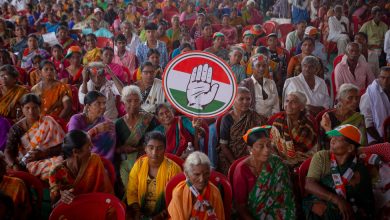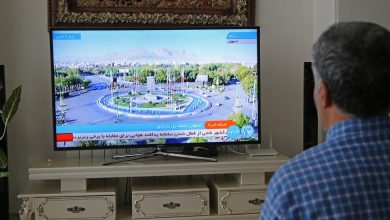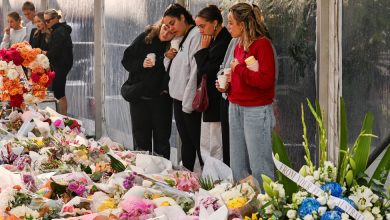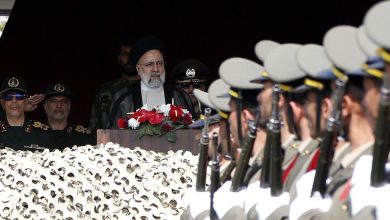Despite Soaring Deaths in Somalia, Monitor Says It’s Not Yet a Famine. Some Object.
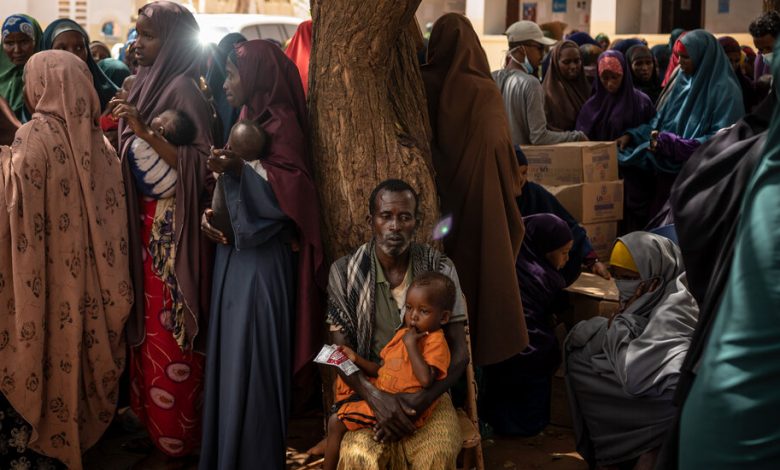
BAIDOA, Somalia — In drought-ravaged Somalia, where the starving are streaming into giant refugee camps, it looks like a famine.
In Somalia’s malnutrition wards, where the silence is pierced by the keening of mothers who have lost a child, it sounds like a famine.
Yet the international organization responsible for monitoring global hunger, in a report released Tuesday, declared that the dire crisis triggered by Somalia’s worst drought in 40 years does not constitute a famine — at least not yet.
The organization, the Integrated Food Security Phase Classification, known as the I.P.C., determined that conditions in Somalia’s worst-hit areas have come close to, but not crossed, the threshold needed to formally declare a famine. But if the drought stretches into next spring, as meteorologists expect, a famine is likely then, the body said.
“Even more appalling outcomes are only temporarily averted,” it said.
The reticence of the I.P.C., which is controlled by United Nations bodies and major relief agencies, is not unusual: It has declared a famine only twice in the past decade, in Somalia in 2011 and South Sudan in 2017. The “F-word,” as aid workers archly call it, retains an emotive resonance, able to galvanize global attention and, crucially, to unlock vast amounts of donations. It should be used in only the most extreme situations, the thinking goes.
But Somalia has already plunged deep into that worst-case scenario, according to aid workers, doctors and diplomats who say they are confounded by the I.P.C.’s latest assessment, or believe its methodology is flawed.
By the I.P.C.’s own estimates, the number of acutely malnourished Somalis has more than doubled since January to 5.6 million, of whom 214,000 are already in famine-like conditions. How many have died is unknown, but the number is rising rapidly. The World Health Organization will publish its first estimate of drought-related deaths in the coming weeks, a spokeswoman said. Aid officials expect a death toll in the tens of thousands, if not more.
The gap between the severity of the crisis, which American officials say matches the layperson’s definition of a famine, and the I.P.C.’s refusal to call it by that name, has prompted a growing debate among aid experts.
The I.P.C. works in 30 countries and has long been considered the gold standard in hunger measurement. But some question whether it is seeing the full picture in Somalia.
Read More About Extreme Weather
- Ecotourism: As climate change reshapes the American economy, New Mexico is trying to capitalize on its natural beauty. But extreme weather keeps getting in the way.
- Reversing Course: The Netherlands, a country long shaped by its overabundance of water, is suddenly confronting drought. Its population is hoping to engineer its way to safety.
- Drying Out: The Mississippi River, known for its vast reach and powerful currents, has withered to levels not seen in decades, choking shipping lanes and endangering drinking water supplies.
- Smoke Pollution: Smoke from wildfires has worsened over the past decade, potentially reversing decades of improvements in Western air quality made under the Clean Air Act, according to new research.
Areas badly hit by the drought are controlled by the Islamist militants of Al Shabab, which prevents international aid groups from working there and hinders efforts to gather complete information about the impact of the drought. In interviews at the sprawling camps around Baidoa, residents of those areas said many died back in their villages, or on the roads.
Others say the culprit is climate change. To detect famine, the I.P.C. measures rates of hunger, malnutrition and death over short periods, usually three to six months. But the drought in Somalia — and across the wider Horn of Africa, including Ethiopia and Kenya — is now stretching into its third year.
The result, experts say, is that Somalis are dying at a rate that falls just below the threshold for declaring a famine — but over such an extended period of time that it may eventually kill as many people as a famine does.
“The system has a problem,” said Peter Hailey, a former official with the U.N. Children’s Fund in Somalia, now part of an independent committee that reviews the I.P.C.’s findings. “It’s hell already in Somalia, even if we don’t cross the lines. People are dying and losing their livelihoods in great numbers — and it looks like that situation is going to continue into the future.”
At this rate, Mr. Hailey said, this crisis could kill as many people as the famine in 2011, when 260,000 Somalis died.
In an interview, José Lopez, who heads the I.P.C.’s global operations, insisted that its work was grounded in facts and scientific analysis. Several hundred officials collected the latest data from camps and drought-hit areas, he said. The decision not to call a famine was dictated by numbers, not subjective impressions.
“I know our results don’t always align with what public opinion or stakeholders think, but they are absolutely based on evidence,” he said.
But Mr. Lopez also acknowledged the growing debate about the I.P.C.’s methodology. “This is an issue we are aware of,” he said, adding that he expected the group’s board of governors to consider changes soon.
In the report published Tuesday, the I.P.C. found that although a rapid response by aid groups had staved off earlier predictions of a famine this fall, the respite is temporary.
A combination of factors, including the continued drought, the fight against Al Shabab militants, and an expected reduction in foreign aid, will cause the affected population to rise to 6.3 million in early 2023, and to 8.3 million from April onward — about half of Somalia’s population.
At that point, it said, a handful of areas including the one around Baidoa will likely enter a formal famine.
Even so, a growing number of aid agencies say a famine should be declared now.
“This is about the lives of millions of people,” said Shashwat Saraf, emergencies director for East Africa at the International Rescue Committee. “It’s important that we go ahead now.”
The debate reflects the enduring power of the famine label, for better and worse. In the West, it conjures up the horrific suffering of the Ethiopian famine of 1984, and of the celebrity-driven advocacy of the Live Aid fund-raising concerts.
For aid groups, a famine elevates one crisis above competing disasters.
Television crews from major networks scramble to famine sites. Citizens touched by those images donate millions of dollars in response to fund-raising appeals. Politicians pay attention. Governments open their wallets.
The U.N. relief fund for Somalia doubled in size within days of a famine being declared in 2011 — even through the severity of that crisis was already well known. Somalis paid a price for that hesitation: It later emerged that half of the victims died before the formal declaration was made.
Politics is a factor, too. Although the I.P.C. makes the technical determination of famine, announcing one is ultimately a decision for national governments. Many do not relish that prospect, or even use hunger to military ends — in recent months, the leaders of Ethiopia and South Sudan faced renewed accusations that they use starvation as a weapon of war.
Somalia’s President Hassan Sheikh Mohamud has expressed some reticence about declaring a famine, apparently fearing that it would divert funds from other priorities. But his officials insist that science is their main guide.
“There are no politics in this, it is only data,” Somalia’s drought envoy, Abdirahman Abdishakur, said last month.
It might seem there is little downside to declaring a famine, with its surge in attention and resources. But experts say the reality is more complicated.
Numerous hunger crises are underway in countries like South Sudan, Yemen, Nigeria and Haiti. At least 222 million people in 53 countries will face food shortages by the end of this year, of which 45 million risk starvation, the U.N. relief chief, Martin Griffiths, said recently.
But every crisis is not a famine, and aid groups and donors need a common standard to identify the most needy situations — one reason for the creation of the I.P.C. in 2004. “Otherwise,” Mr. Lopez said “anyone can declare a famine, or hide a famine, for any kind of political reason.”
Still, determining a famine is a matter of subjectivity as well as science. The agreed thresholds effectively represent a moral choice about “what the world thinks is too much,” Mr. Hailey said. And obtaining accurate data is a challenge.
In the Somali town of Baidoa, aid workers glean a picture of the situation in Shabab-held areas from newly-arrived refugees. But the hungry and desperate are not always good sources of accurate information, they say. And the unusually long drought has caused donors to question their own assumptions about how to determine a famine.
“We are in uncharted territory,” said Kate Foster, the British ambassador to Somalia.
A senior United States official, speaking on condition of anonymity to avoid alienating humanitarian partners, praised the I.P.C.’s work but said its latest findings called into question if “the system is working any more.”
In interviews, many experts lamented that the intense focus on a famine declaration was distracting from widespread suffering and death already taking place. According to the I.P.C. at least 1.5 million Somalis are already in “phase four” — not quite famine, but enough to cause widespread deaths.
“Waiting for a famine to be declared is not the right approach,” Mr. Lopez said.
The deteriorating situation has created a conundrum for aid groups in Somalia, causing them to ratchet up their language to generate a sense of urgency, but stopping short of using the unqualified ‘F-word’.
“We keep changing the language from ‘forecast famine’, to ‘risk of famine’, to ‘near famine’,” said Mr. Saraf, the aid worker. “But that confuses the message and impedes resources coming in. It’s like a sword hanging over your head — everyone is waiting for it to fall.”
What matters for many Somalis is how quickly more help will arrive.
At Baidoa’s main hospital, Dr. Said Yusuf admits at least eight patients every day to a ward that is filled with malnourished, sickly infants. Often, he said, parents arrive carrying bundles that they tell medical workers contain their unconscious children.
But when doctors unwrap the bundles, they find that the child is already dead.
“Please,” said Dr. Yusuf. “If there is to be intervention, it must come now, before more are lost.”
